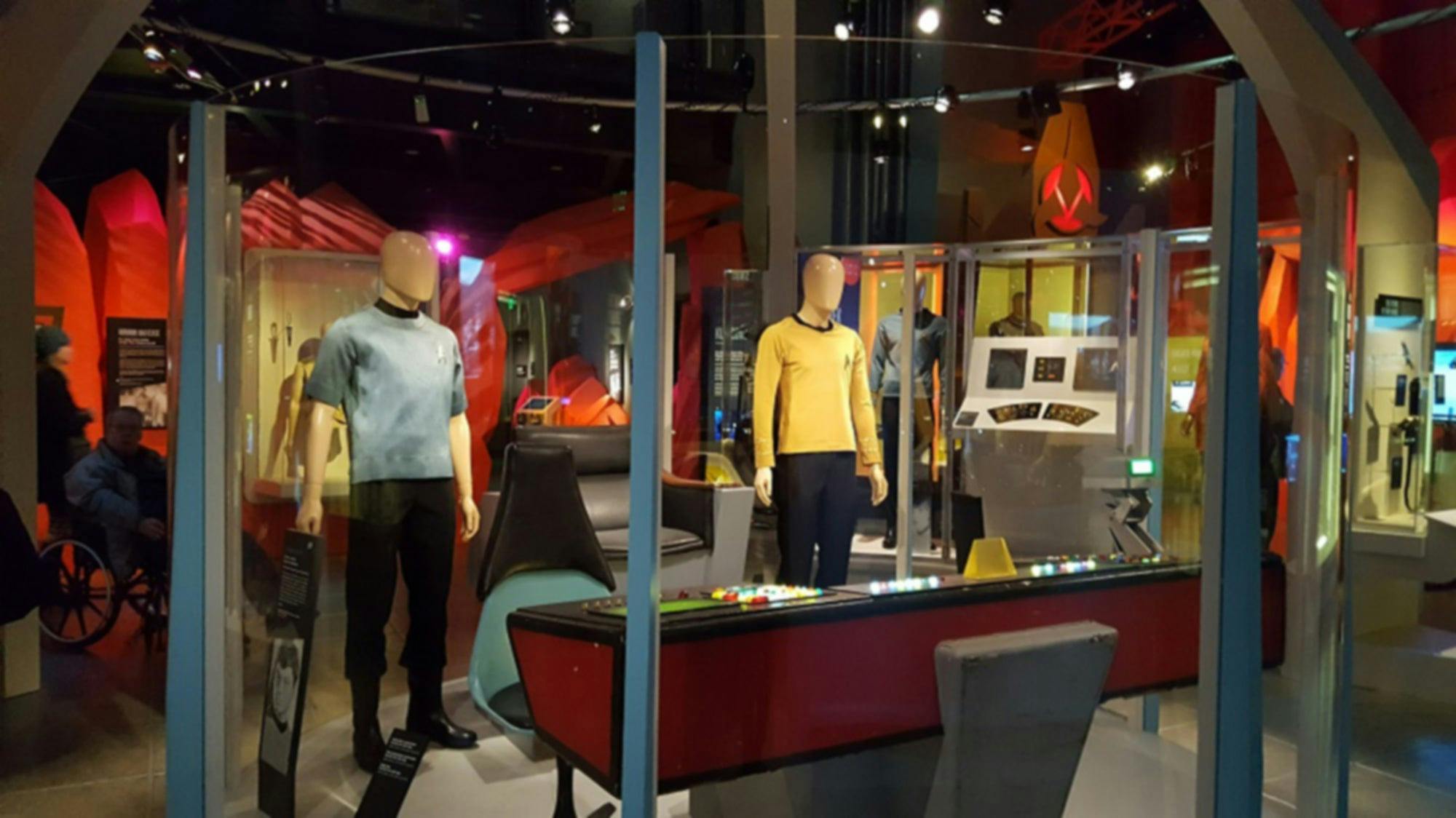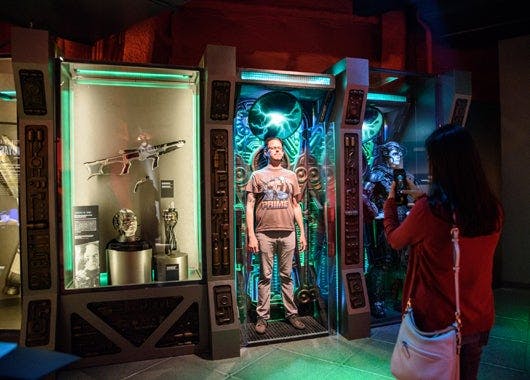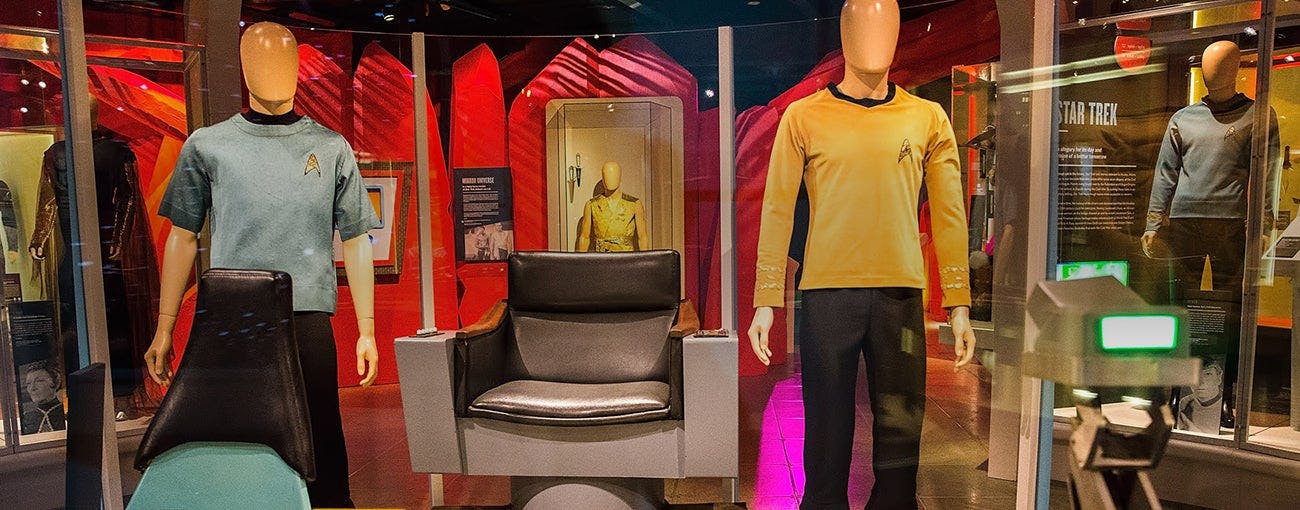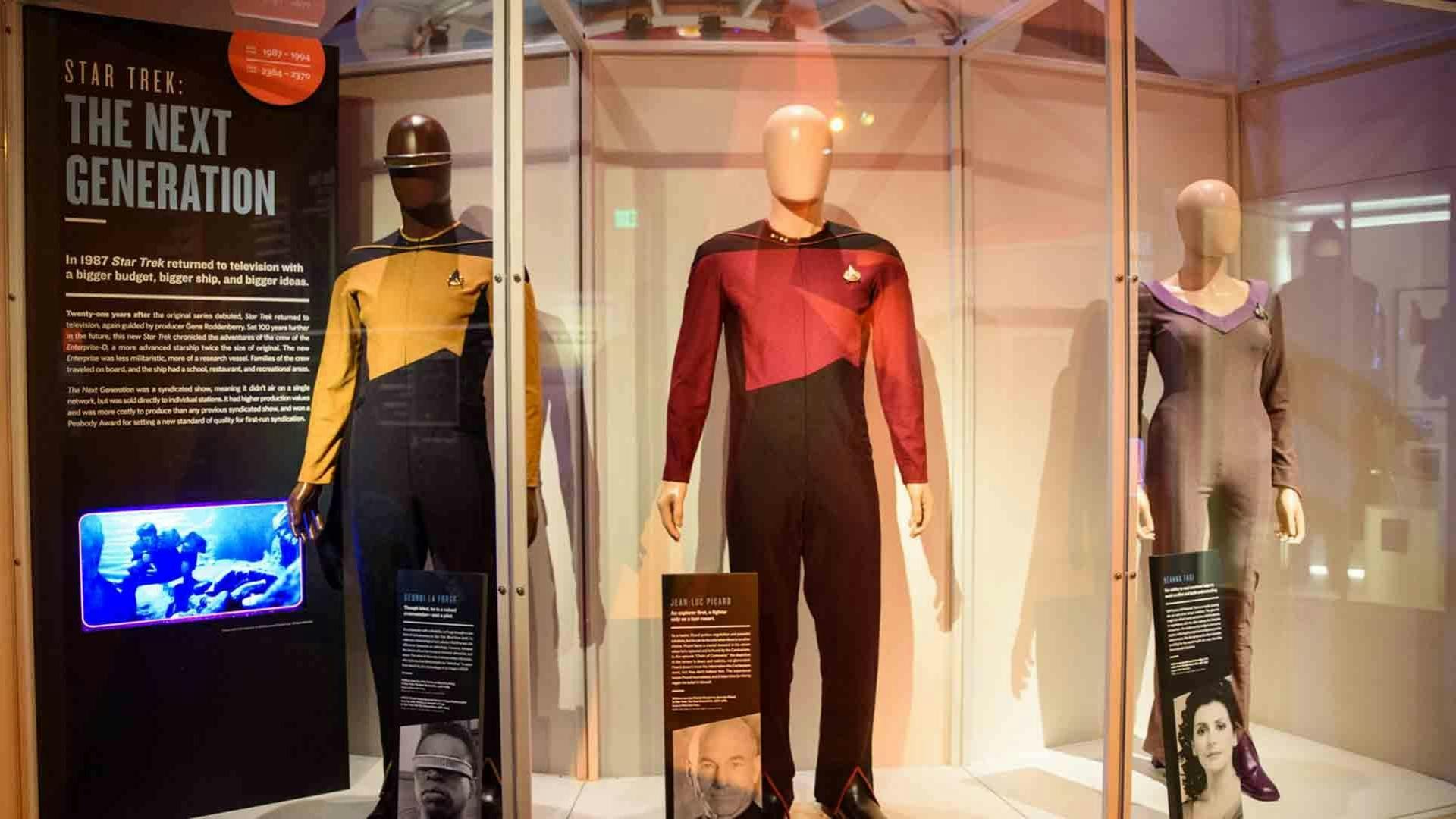
Henry Ford Museum
Star Trek has always been about seeking out new worlds and civilizations, but a new traveling museum exhibit could also help children better understand our own.
On loan from the Museum of Pop Culture in Seattle, "Star Trek: Exploring New Worlds" begins the second leg of its national tour at the Henry Ford Museum of American Innovation May 11. I toured the exhibit before it recently beamed out of the Indianapolis Children’s Museum, and was thrilled to be surrounded by so many props and models from virtually every iteration of the franchise. I even realized my childhood dream of sitting in the captain’s chair.

MoPop
But perhaps even more exciting than seeing the original bridge set, Ricardo Montalbán’s Wrath of Khan costume, or the actual filming model of the Enterprise-D, were the conversations the exhibit sparked. Star Trek has always been a sci-fi morality play at heart, but it was interesting to witness how museum educators framed certain concepts, allowing kids to consider and discuss some of the hot-button topics the show has touched on over the years: Should we interfere with alien societies, possibly less advanced than ours? Should artificial lifeforms have the same rights as people? Are there such things as monsters, or are they merely beings we just don’t understand yet?
Encouraging these types of conversations is nothing new for the Indianapolis Children’s Museum. "The Power of Children" exhibit focusing on civil-rights pioneer Ruby Bridges, Anne Frank, and Ryan White (one of the first AIDS patients to gain the national spotlight), has sparked many a complex conversation over the years. Exhibits Manager Monica Humphrey says that’s by design. In-house educators and consulting teachers create discussion prompts for children and adults that allow the kids to steer the discussions.
“It’s important for kids to have open, constructive conversations with the adults in their lives and come up with their own conclusions,” Humphrey said, via e-mail. “We try to figure out the best way to approach these topics, that will encourage the children to ask questions and gain a deeper level of understanding. Some themes we see in the series may not have overt messages, but if you dig a bit deeper, it makes you think of our own world differently.”
Because Star Trek is a fictional universe, it can provide a safe space to discuss those and other challenging topics that hit closer to home. For example, a prop like Lieutenant Uhura’s original costume can encourage families to discuss Nichelle Nichols’ role in breaking racial conventions of the time, says museum educator Todd Norris. Kirk and Uhura’s interracial kiss was a first for television and prompted several stations in the South to threaten a boycott of the show. Over the three seasons the show was on the air, Uhura became a role model for millions, and Nichols was even persuaded by Dr. Martin Luther King to remain on the series when she considered leaving for Broadway.

StarTrek.com
Norris remembers being fascinated by the episode The Original Series’ “Let That Be Your Last Battlefield” episode, where one humanoid alien hunts another. The hunter is white on one side, black on the other, while the other alien is also bi-colored, but on the reverse sides.
“The Enterprise becomes involved in the dispute between the two, who have a centuries-old hatred of each other because of this difference,” Norris said. “But the crew of the Enterprise views them as equal; which color is on which side is irrelevant. The aliens wind up annihilating one another, leaving the crew baffled. This isn’t a subtle episode, but the exploration of racism is clear, and a theme that multiple episodes in multiple series would continue to explore. Even as a kid, I recognized what the show was trying to do, and that episode has always stayed in the forefront of my memories.”
Humphrey says the ultimate goal is for children to continue to ask questions and seek out more knowledge of an issue with each additional visit. Going from the safe space of the fictional Star Trek universe, kids could then journey elsewhere in the museum to learn about Bridges and the real-life struggles she endured as one of the first black students to integrate the New Orleans school system in 1960. Eventually that could lead children to ponder how we all interact with each other today.
Another important theme that museum educators hope parents and kids get out of the exhibit is possibility. Although Humphrey doesn’t consider herself a communicator-carrying Trek-fan, she did grow up watching Star Trek: The Next Generation.
“I loved the adventure and camaraderie among the crew, and most of all, seeing the strong women on the show,” Humphrey said. “It was something that I didn’t know at the time that I needed to see.”
Families coming to the exhibit would often discuss their dreams that Star Trek helped inspire, Norris says.

StarTrek.com
“Conversations often center around the idea that anything is possible, and that we aren’t limited in the ways that some people have been in the past,” Norris said. “It might be a young girl saying she wants to be an astronaut or a family discussing where the grownups were during a milestone achievement in our space program. One of the great things about facilitating the programs here is that the questions, comments, and discussions are as varied and surprising as the world of Star Trek itself.”
The Henry Ford Museum of American Innovation will host the "Exploring New Worlds" exhibit until September. Spokeswoman Wendy Metros says staff is still developing programming for the exhibit and didn’t answer what, if any, similar conversation prompts they might use.
Hoosiers who missed the traveling exhibit can still get their Star Trek fix, though. The Indianapolis Children’s Museum still has a few props remaining on permanent display – including costumes and an escape pod from the J.J. Abrams movies – and a George Takei-narrated documentary, The Future is Here - How Sci-Fi Becomes Reality, playing regularly in the planetarium theater.
“We hope kids will not only ask questions about topics,” Humphrey said. “[But that] they’ll be inspired to accomplish something incredible, to bring something fictional into our reality.”
Although Robert Annis (he/him) has been obsessed with space and science fiction most of his life, his adventures are, sadly, much closer to terra firma. A freelance adventure-travel writer, his dream assignment is catching a ride on one of the first SpaceX flights.

